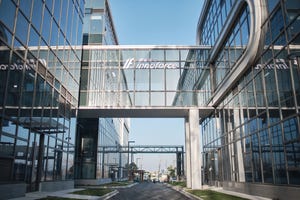
Raw materials, manufacturing, and distribution all pose sustainability challenges for the biopharma industry, but to meet goals, organizations must work together to create meaningful changes, say experts.
Environmental, social, and governance (ESG) documents are published and sent out across the newswires, but often sustainability-related statements are seen as box-ticking exercises or examples of “greenwashing.” However, when large pharmaceutical companies including GSK, AstraZeneca, and Roche launch a major sustainability program — calling on their network of suppliers to take action on sustainability commitments and make improvements in emissions, energy, heat, transport, waste, water, and biodiversity — it is clear that the conversation about sustainability is getting serious.
“Three or four years ago, most people weren’t talking about sustainability,” Joe Hess, senior director of environmental health, safety, and sustainability at Gilead Sciences, said at BPI West in March.

Image: DepositPhotos/Cinemaniko
While many believe the health sector does not contribute significantly to global emissions, “the health sector generates four to five percent of total global emissions,” Hess said. “This is mainly to do with the supply chain and the impact from globally shipping [equipment and medicines].”
As part of the same presentation, Merete Miles, senior director environmental sustainability at Thermo Fisher Scientific, said with such a complex global value chain, “we need to work together to solve sustainability and create circularity.”
Referencing BioPhorum’s Technology Roadmap Vision 2.0, the two stressed the urgent need to implement sustainable measures within the biopharma community, outlining how BioPhorum members are prioritizing decarbonization and the need to embed circularity – a means to remove waste and increase the reuse of resources – in technical and environmental systems.
They then broke this down into four segments: 1) Raw materials, 2) Manufacturing, 3) Distribution, 4) End of life.
Raw materials
According to Miles, the three main critical problems associated with raw materials are the carbon impact has not been well defined, raw material source extraction and use is currently unstable, and the act of recycling is extremely complex for the pharmaceutical industry due to the types of material and substances involved.
To tackle these issues, specific key actions should be adopted. We need to “engage with the supply chain to better understand the carbon impact, embed eco design principles at an industry level and design with sustainability in mind, and [we need] to agree on definitions of sustainable raw materials,” said Miles.
By establishing the degree of the problem, completing facility buildouts and expansions with sustainability in mind, and collectively defining what a sustainable raw material is, the industry will also be able to manufacture the product more sustainably too.
Manufacturing
Hess said that when it comes to production in the biopharma space, “manufacturing is not designed with sustainability in mind” and the scope should cover “all stages of production.”
He told the audience: “If we can minimize the amount of resources we use in manufacturing, then that is better for the environment and typically better for production if we can do it smaller and do it quicker.”
Such an issue could be overcome by designing products upfront that are not so complex to produce and therefore do not have as great of an impact on the environment, Hess added.
Furthermore, the role facilities play form a part of the sustainability discussion. “When we’re bringing on new facilities, we should set up the validation plans so that we have more flexibility,” said Hess, adding this “has big gains from an operational standpoint.”
Retrofitting old plants can also aid sustainability. “That’s the dream to build a facility once, and then you can take-out stainless-steel reactors and put in single use technology [SUT],” said Hess, though noted this is dependent on the development success of a company’s molecule.
However, SUTs can be more sustainable and more efficient because “they are better from a safety standpoint as they require less storage space, less cleaning” and employees are not exposed to as many chemicals.
The pre-fabricated construction method was also discussed at Advanced Therapies 2023 in London in March, with Ali Bahari, bioprocess design consultant at Scitech Engineering saying firms can bring candidates to market quicker due to less site work required.
Distribution
Miles questioned how a product could be packaged and transported more sustainably. While ideas such as using electric vehicles and ocean, rather than air, freight play a part, she said the bigger picture is to look at the full life-cycle of the product and whether it has “been designed to be continued” in order to maintain circularity. “The end of life should be the beginning of a new life for the product.”
Hess agreed, adding when considering how a product is packaged, biopharma companies should think about enabling the container to be reused at its end of life and how we can make more of it in some way.”
The design of the shipping container should be clear and “validated” and the box should show how many times it can be reused and how the process would work to ensure circularity across the board.
End of life
As aforementioned, the primary goal is for the product to be used again in some shape or form. The solutions to alleviate the amount of waste generated from end-of-life phased products range from the reuse of materials in unused or expired medicine and associated packaging through to the recycling of shipping containers.
Hess said the two critical problems surrounding this are the amount of waste, in both medicines and packaging, and the general knowledge and awareness of the end-of-life phase.
Life Cycle Analysis’ (LCA’s) should be completed in collaboration with end users to fully understand the full life cycle and the effect it has on the environment.
Enablers
After identifying these specific problems across all four aspects, industry must move and think about the key enablers available to solve them, Miles said.
This incorporates the abundance and availability of new technology (“which is often more sustainable to use”), the filing of drug products with the environment in mind, and forging connections to measure of the impact as “what you do not measure does not get done.”
Miles emphasized how collaboration is a word that is so important and intrinsically linked to sustainability. If you are to create an industry culture of sustainability through collaboration it spurs people “to get something done as one company cannot do it alone.”
About the Author
You May Also Like









